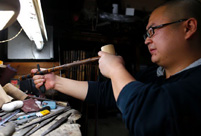 'Jin' named the word of the year by cross-strait netizens
'Jin' named the word of the year by cross-strait netizens Chinese scientific expedition goes to build new Antarctica station
Chinese scientific expedition goes to build new Antarctica station
 Chinese naval escort fleet conducts replenishment in Indian Ocean
Chinese naval escort fleet conducts replenishment in Indian Ocean 17th joint patrol of Mekong River to start
17th joint patrol of Mekong River to start China's moon rover, lander photograph each other
China's moon rover, lander photograph each other Teaming up against polluters
Teaming up against polluters
 |
| Han Shuo plays with her 11-month-old brother Han Bokang at home. Photo: Li Hao/GT |
Awareness needed
Another issue facing rare disease patients is that the disease is not well-known, Han said.
According to Han's rough estimates, before being officially diagnosed, 30 percent of rare disease patients need to see 5 or 10 doctors, nearly half are misdiagnosed with some other disease and 75 percent cannot receive scientific, regulated treatment plans.
For Gaucher's disease, the treatment plan is still being developed.
Song Xiaofang's daughter, 4-year-old Cao Linfei, was also diagnosed with Gaucher's disease in 2012. Cao had come to within inches of death at the beginning of 2013, and the doctor at the Naval General Hospital in Haidian district suggested hemopoietic stem cell transplant.
For a brief six-month period, Cao was China's first successful case of hemopoietic stem cell transplant being used to combat Gaucher's disease, after her operation in April. However, in October, her blood platelet level came down again.
The parents, who had already spent 600,000 yuan on the treatment, are baffled. Zhang Bo, Cao's clinical doctor, said that the symptoms she's showing are a complication from the transplant, but he can't be absolutely certain whether she can recover again.
When Han Qi was informed of Cao's condition, he gave up on the idea of letting Han Shuo go through with a transplant. An operation may not work so well and drugs are too expensive, so the only treatment Han Shuo is getting right now is blood transfusion and calcium pills, but that is only a superficial cure.
"At the beginning I often felt I was alone," the father said. "I had nobody to talk to about this disease and I couldn't see how she would get the treatment."
Existing networks
"The help rare disease patients receive usually comes from grass-roots organizations or other patients of these diseases," Huang said. "On the Internet, our organization has put in touch about 20,000 people suffering from 33 different diseases. But that's still a small number."
In recent years, a number of organizations were established, such as the Hemophilia Association of China, PKU Union, LAM China and albinism.org. In 2010, a foundation was set up at the Peking Union Medical College Hospital to support the patients of LAM/TSC, a rare disease that destroys lung tissue and prevents free flow of air.
Some of the organizations were started up by people suffering the disease. Wang Yiou, a patient of osteogenesis imperfecta, commonly known as brittle bone disease, started the China-Dolls Center for Rare diseases in 2007.
Her colleague, Xiao Lei, told China Fortune in a 2011 article that patients of rare diseases often thirst for more understanding and communication from peers.
"We now support more than 200 patient organizations for rare diseases in the country, whether it's through Internet forums, QQ chat groups or any other way. Patient organizations have provided a platform for information exchange and emotional support for rare disease patients," he said.
In Cao Linfei's case, the patient organization and rare disease foundation also provided financial support. Song received 200,000 yuan, which enabled her to pay for her daughter's operation.


 People prepare for upcoming 'Chunyun'
People prepare for upcoming 'Chunyun'  Highlights of Beijing int'l luxury show
Highlights of Beijing int'l luxury show Record of Chinese expressions in 2013
Record of Chinese expressions in 2013 China's moon rover, lander photograph each other
China's moon rover, lander photograph each other 17th joint patrol of Mekong River to start
17th joint patrol of Mekong River to start Spring City Kunming witnesses snowfall
Spring City Kunming witnesses snowfall Heritage of Jinghu, arts of strings
Heritage of Jinghu, arts of strings Weekly Sports Photos
Weekly Sports Photos PLA elite units unveiled
PLA elite units unveiled  China's stealth fighters hold drill over plateau
China's stealth fighters hold drill over plateau Chinese navy hospital ship's mission
Chinese navy hospital ship's mission  "Free lunch" program initiated in NW China
"Free lunch" program initiated in NW China  Rime scenery in Mount Huangshan
Rime scenery in Mount Huangshan DPRK's Kaesong Industrial Complex
DPRK's Kaesong Industrial Complex 'Jin' named the word of the year
'Jin' named the word of the year Day|Week|Month